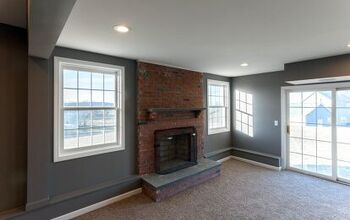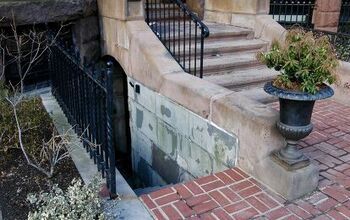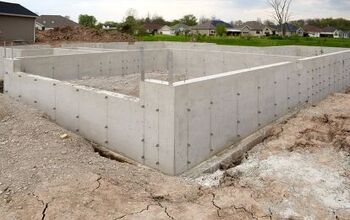What Is A Bulkhead Basement? (Find Out Now!)

Ever been to the northeast? You might have noticed these strange metal doors on the ground near some of the homes. Do those mysterious structures lead to Narnia? Not quite. While basement bulkheads aren’t the most common, they are practical structures that will connect you to the underground basement of a home.
Basement bulkheads are cement structures that provide outdoor access to the basement. They consist of an above-ground set of swinging doors that lie flush or angled on a cement foundation, and a staircase leading down to the ground level. Basement bulkheads are usually found in old homes of the northeast because they provide direct access to underground root cellars.
Do You Need Basement Remodeling Services?
Get free, zero-commitment quotes from pro contractors near you.

Why Do Homes Have Basement Bulkheads?
Basement bulkheads are useful, practical structures that provide direct outdoor access to the basement. They are seen most often in older homes of the northeast. Many homeowners at the time utilized them to access their root cellars. They stored and preserved vegetables, fruits, and other foods in these.
Having a basement bulkhead made it easier to transport this farm produce in and out of the cellar. Most homeowners also didn’t favor the look of an interior cellar door design. Exterior bulkhead doors saved them from having to build one inside.
Today, basement bulkheads offer more modern conveniences. They are useful for moving heavy or dirty objects directly in and out of the basement, without traveling through the home. They are also practical as a second form of egress. If you have a furnished living space in your basement, this is a legal requirement.
Basement Bulkhead Pros
Basement bulkheads are a less common form of basement entry, but have their advantages. Having outdoor access to the basement is more convenient. You can move heavy or dirty materials straight into the basement. This prevents the need to travel inside the house to get to the ground level.
Basement bulkheads can also offer a second form of egress. This is required in building codes if the basement is a living space. Metal bulkhead doors are cheaper to construct than other basement egress types like dog houses or clam doors. Their doors provide direct storm shelter when needed.
- Direct outdoor access to basement
- Store heavy, dirty objects without having to enter upper home
- Second form of egress
- Metal doors are affordable to install
- Storm shelter protection
Basement Bulkhead Cons
Basement bulkheads come with a few drawbacks. The metal bulkhead doors are often very heavy and awkward to open from the inside. If built too tightly, they can prevent outside ventilation. This may cause stagnant air and moisture or mildew buildup beneath the doors.
If the bulkhead doors are in poor shape, rain and snow can leak through and cause water damage. Basement bulkheads are also somewhat visually gaudy and can appear rusty.
- Heavy metal doors, awkward to open
- Can prevent basement ventilation
- Water damage from rain or snow leaks
- Visually unpleasant, rusts easily
What Are Basement Bulkhead Doors?
Most basement bulkheads are covered by an above-ground metal door structure. These handled double doors with locks swing open to reveal a staircase. These stairwells are usually made of wood or concrete, and lead to a separate door entrance to the basement.
Types of Basement Bulkhead Doors
Bulkhead doors come in a variety of materials and styles. If you want to install or replace your own, take into consideration the aesthetic, cost, and durability differences of each.
- Metal Doors: Metal doors of steel or aluminum are the most common bulkhead doors. Companies like BILCO sell and install them for affordable prices. Metal bulkhead doors are usually the cheapest to install and maintain. Unfortunately, they aren’t very pleasing to the eye. Aluminum versions rust easily and aren’t the most water-resistant.
- Wooden Doors: These might be a good choice if you enjoy challenging DIY projects. If you are crafty, you can build these yourself using rot-resistant materials and finishes. You will save money on installation, and they will look more attractive. A drawback is that they are less water-resistant than some alternatives.
- Clamshell Doors: A clamshell door consists of one door unit that flips open on a hinge. Companies like ClamDoor designed them to be highly water-resistant, easy to install, and extremely hardy. They protect your basement interior from water damage and look nicer than clunky metal doors. They come at a heftier price: expect to pay at least $1,500 for a quality clamshell door.
How to Take Care of Your Basement Bulkhead
Since basement bulkheads provide outdoor access to your home’s interior, they need to be sturdy. A poorly maintained entry point leaves the house vulnerable. Water damage, inclement weather, break-ins, and wild animals are all threats. So make sure your bulkhead doors stay in good shape:
- Check them for rust. Rust leads to erosion, which will cause leak points. Paint your doors to keep the rust at bay (and make them look more pleasant!).
- Stand inside to see if sunlight leaks through the doors. If so, it might mean your doors are not air-tight enough. This could allow rain and snow to leak through.
- Make sure the locks are in working order. This is essential to your home security.
- Cover the doors in the snowy or rainy seasons to prevent water leakage.
- Regularly check the stairwell for signs of mildew or mold.
- Ventilate your basement by keeping the doors open a couple of times a year.
When to Replace Your Bulkhead Doors
How will you know if it’s time to replace your basement bulkhead doors? Rust buildup, erosion, light and water leakage, or mildew in the stairwell are tell-tale signs. You can either complete the construction and installation yourself or hire a professional contractor.
Doing it yourself can save you a lot of money. If you’re experienced in home construction and want to customize them, you can build and install alone. Note: This DIY project is not for beginners. Improper installation can lead to a host of problems. Your home could be more susceptible to break-ins or water damage.
Hiring a professional contractor to install bulkhead doors is the safest bet. BILCO is the most popular company for this. Purchase of BILCO doors and installation can cost anywhere from $1,500-$6,000. You can also just buy the doors themselves from Home Depot or Lowe’s for as low as $500, then hire an independent contractor to install.
Don’t Want to Do It Yourself?
Get free, zero-commitment quotes from pro contractors near you.
Related Questions
We’ve covered a lot about basement bulkheads and bulkhead doors. But you might have more questions. Here are some of the most popular related questions on this topic.
What is a Bulkhead?Is a ‘bulkhead’ the same as a ‘basement bulkhead’? Yes and no. A ‘bulkhead’ in construction or real estate refers to many different things. The term refers to any wall or partition that separates or protects something from damage.
A bulkhead can be a dropped ceiling wall that conceals wiring. It can also be an exterior wall or embankment surrounding a house perimeter that protects it from flooding or fire. A bulkhead can even refer to a rock retaining wall.
What are bulkhead door alternatives?Metal bulkhead doors are affordable to purchase and install. But many homeowners hate the look of them. They can rust easily and erode over time. Luckily there are some good bulkhead door alternatives!
- Clamshell doors: High-quality, durable, and water-resistant.
- Deck hatches: Cheap, inconspicuous, and easy to install.
- Hidden doors: Completely invisible and increase the value of a home.
Your bulkhead doors could be leaking for several reasons. They may be rusting and eroding. There might be improperly sealed joints where the bulkhead doors meet the foundation. There may also be cracks in the bulkhead foundation itself.
If your joints are not sealed properly, fill in the cracks with a concrete sealant. Then apply waterproof sealant around the edges of the bulkhead door both inside and outside. If the issue is a rusting or eroding bulkhead door, you will likely have to replace them. Consider alternatives to metal types to avoid rusting in the future.
Do You Need Basement Remodeling Services?
Get free, zero-commitment quotes from pro contractors near you.

Summing It Up
To sum it up, basement bulkheads are concrete structures that provide outdoor basement access. They consist of a stairwell, a cement foundation, and horizontal or angled swinging doors.
Most basement bulkheads are found on old homes of the northeast. Homeowners would use these convenient entrances for preserving food in their root cellars. Today, basement bulkheads provide easy basement access and a second form of egress for your living space.
Bulkhead doors are usually made of steel or aluminum and swing open to reveal the staircase. They are prone to rust and leakage and must be maintained so your basement is not left vulnerable. While they require upkeep and replacement, they are fairly affordable to have replaced. What type of doors you choose will depend on price, visual appeal, and the level of durability you’re looking for.

We are a team of passionate homeowners, home improvement pros, and DIY enthusiasts who enjoy sharing home improvement, housekeeping, decorating, and more with other homeowners! Whether you're looking for a step-by-step guide on fixing an appliance or the cost of installing a fence, we've here to help.
More by Upgraded Home Team






















![12 Washing Machine Brands to Avoid [with Recall Data]](https://cdn-fastly.upgradedhome.com/media/2023/07/31/9075781/12-washing-machine-brands-to-avoid-with-recall-data.jpg?size=350x220)




